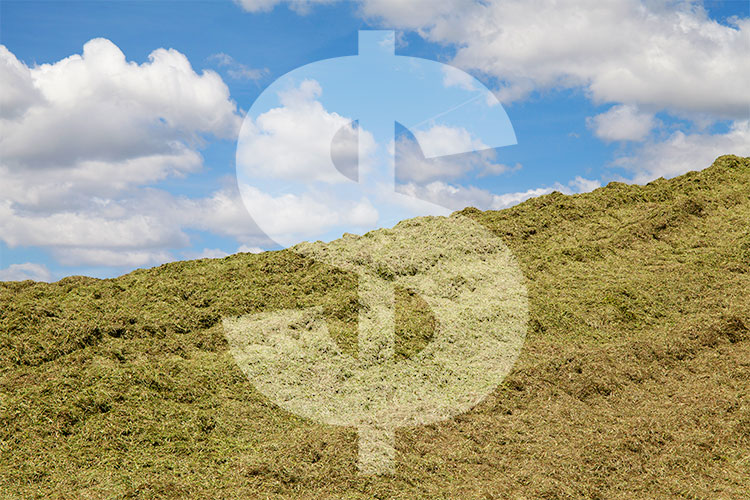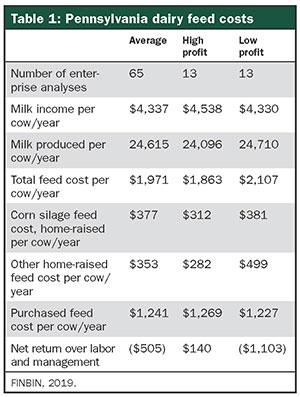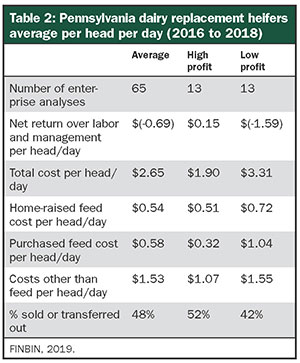
The cropping enterprise is an integral component to the success of the dairy enterprise and the whole farm in generating profit. Purchased feed costs are usually monitored regularly by producers. However, purchased feed does not tell the whole story. The costs for each individual home-raised feed, both per acre and per ton, allow a producer to understand more completely one of the biggest expenses to producing milk and growing replacements.
Balancing feed and production

To conduct the profitability assessment for the farms, the Penn State Extension dairy team used the Year-End Analysis (FINAN) software developed by the University of Minnesota. This software allows the user to conduct detailed enterprise analysis on the livestock and crop enterprises of the farm.
Table 1 shows the average, top, and bottom 20% profit groups for home-raised feed cost, purchased feed cost, and net return over labor and management 2016 to 2018. Milk income and production per cow were similar between the average farm as well as the high-profit and low-profit groups.
There was a $1,200 difference in net return between the average of the high-profit group and low-profit groups. Since milk income was similar amongst the groups, the variation in net return was mostly with expenses. Total feed costs accounted for one-third of the difference. The high-profit farms averaged a total feed cost per cow per year (this excludes the replacement heifers) of $1,863 while the low group had a cost of $2,107.
Splitting up the total feed costs into purchased and home-raised, the purchased feeds were similar between the profit groups, and the average of all farms. The home-raised feeds accounted for the cost difference. The low-profit group had inefficiencies throughout their cropping enterprise, which were higher than average and nearly double the cost the high-profit farms achieved.

A second source of variation impacting profitability was the replacement heifer enterprise. Feed expenditures represent a large portion of the total cost required to raise a heifer. Table 2 shows the average feed and non-feed costs per head per day. The average feed cost annually per head per day was $1.12.
The high-profit group averaged 30 cents less than this, while the low-profit group was over 60 cents higher. The higher feed cost in the low-profit group was not only associated with home-raised feeds, as was seen in the dairy enterprise, but also purchased feed. A factor to consider is the farm’s available feed sources.
In the data set, farms with the highest amount of home-raised feeds, including all grass hay and corn grain, consistently rank among the highest profit farms. The amount of purchased heifer supplements for each group suggests this is true for the heifer enterprises, too.
This supports a conclusion the extension dairy team has drawn from many years of financial planning with dairy producers: Farms that have a good match of crop acres to the total animal units on the farm are positioned for higher profitability. They buy smaller amounts of purchased feed and raise forages and grains at competitive costs well below the market value of the feedstuff.
Non-feed costs also contributed to the variation in heifer enterprise profitability. High-profit farms spent a dollar a day on non-feed costs for heifers while the low-profit and average farm spent 50 cents more than that per day. Costs were examined on a per-day basis because of the influence heifer management has on the cost to raise a replacement.
The effectiveness of management can be measured by the percent sold or transferred out annually. This examines what percent of the heifer population leaves the system, thus reducing costs in a given time frame. The lower the transfer out rate, the longer a heifer remains in the system, which increases the overall cost.
The high-profit group averaged a 52% transfer out rate, while the low-profit group only averaged 42%. Based on data compiled by the business management team for many years, the results on the heifer enterprise are not unexpected. Comparable to the cropping enterprise, it appears the cost of heifer raising is frequently overlooked as a significant profitability gap in the dairy business.
Evaluate farm capabilities
There are several factors that contribute to the overall profitability of a dairy operation. The enterprises that comprise the dairy operation are in a symbiotic relationship. They need to be evaluated individually and together. Knowing the costs per acre and per ton for the home-raised feeds can help producers make decisions to improve the efficiency and profitability of their farm operation.
Maximum yields, whether it is tons per acre or milk pounds per cow, do not always equate to maximum profit. Managing the dairy to identify the best potential outputs while limiting the costs of inputs will provide a solid foundation to maintain profit even during undesirable markets.







